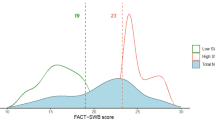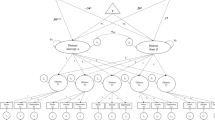Abstract
Numerous herpesvirus infections are associated with clinically relevant outcomes as well as an accelerated HIV replication rate and subsequent disease progression. Stress managementinterventionsmayimprovemarkersofcellularimmunecontroloverlatent herpesvirus infections and these changes appear to be mediated by perceptions of increased social support availability. We examined the effects ofagroup-based cognitive behavioral stress management (CBSM) intervention on distress, dysphoria, perceived socialsupport,andherpesvirus immunoglobulin G (IgG) antibody titers during the 6to 12 months following the intervention. Of those who were initially randomized, 49 HIV-infected men were followed during the 6-to 12-month period after randomization to either a 10-week CBSM intervention (n=31) or amodified wait-list control condition (n = 18). Measures of distress, dysphoria, social support, and blood samples for herpesvirus Ig Gtiters were taken at baseline,immediately following CBSM and at-6-to 12-month follow-up. Men in CBSM displayed maintenance of previously observed intervention effects on dysphoria, reliable alliance support, and herpesvirus IgG antibody titers (i.e., Epstein-Barr virus capsid antigen; EBV-VCA). Intervention-related changes in EBV-VCA were unrelated to changes in lymphocyte subsets (i.e., CD4+, CD8+, and CD4+:CD8+) or changes in measures of dysphoria and social support during the investigation period. Data indicate that HIV-infected men participating in a CBS Mintervention maintain better psychosocial status and immunologic control of latent EBV infection up to 1 year after its conclusion.
Similar content being viewed by others
References
American Psychiatric Association. (1987). Diagnostic and statistical manual of mental disorders (3rd ed., rev.). Washington, DC: Author.
Antoni, M. H., Cruess, D. G., Cruess, S., Lutgendorf, S., Kumar, M., Ironson, G., et al. (2000). Cognitive behavioral stress management intervention effects on anxiety, 24-hour urinary norepinephrine output, and T-cytotoxic/suppressor cells over time among symptomatic HIV-infected gay men. Journal of Consulting and Clinical Psychology, 68, 31–45.
Antoni, M. H., Cruess, D. G., Klimas, N., Maher, K., Cruess, S., Kumar, M., et al. (2002). Stress management and immune system reconstitution in symptomatic HIV-infected gay men over time: Effects on transitional naïve T cells (CD4+ CD45RA+CD29+). American Journal of Psychiatry, 159, 143–144.
Antoni, M. H., Lutgendorf, S., Ironson, G., Fletcher, M. A., & Schneiderman, N. (1996). CBSM intervention effects on social support, coping, depression, and immune function in symptomatic HIV-infected gay men. Psychosomatic Medicine, 58, 86.
Baron, R. M., & Kenny, D. A. (1986). The moderator-mediator variable distinction in social psychological research: Conceptual, strategic, and statistical considerations. Journal of Personality and Social Psychology, 51, 1173–1182.
Beck, A. I., Ward, C. H., Mendelson, M., Mock, J., & Erbaugh, E. (1961). An inventory for measuring depression. Archives of General Psychiatry, 47, 720–725.
Bower, J. E., Kemeny, M. E., & Fawzy, F. I. (2002). Group interventions for individuals with serious medical illness. In M. A. Chesney & M. A. Antoni (Eds.), Innovative approaches to health psychology: Prevention and treatment lessons from AIDS. Washington, DC: American Psychological Association.
Byrnes, D., Antoni, M. H., Goodkin, K., Efantis-Potter, J., Simon, T., Munajj, J., et al. (1998) Stressful events, pessimism, natural killer cell cytotoxicity, and cytotoxic/suppressor T-cells in HIV+ Black women at risk for cervical cancer. Psychosomatic Medicine, 60, 714–722.
Cruess, S., Antoni, M., Cruess, D., Fletcher, M. A., Ironson, G., Kumar, M., et al. (2000). Reduction in herpes simplex virus type 2 antibody titers after cognitive behavioral stress management and relationships with neuroendocrine function, relaxation skills, and social support in HIV-positive gay men. Psychosomatic Medicine, 62, 828–837.
Cruess, S., Antoni, M., Kilbourn, K., Ironson, G., Klimas, N., Fletcher, M. A., et al. (2000). Optimism, distress, and immunologic status in HIV-infected gay men following Hurricane Andrew. International Journal of Behavioral Medicine, 7, 160–182.
Cutrona, C., & Russell, D. (1987). The provisions of social relationships and adaptation to stress. In W. H. Jones & D. Perlman (Eds.), Advances in personal relationships (Vol. 1, pp. 33–67). Greenwich, CT: JAI.
Esterling, B. A., Antoni, M. H., Schneiderman, N., Carver, C. S., La Perriere, A., Ironson, G., et al. (1992). Psychosocial modulation of antibody to Epstein-Barr viral capsid antigen and human herpes virus type-6 in HIV-1 infected and at risk gay men. Psychosomatic Medicine, 54, 354–371.
Fletcher, M. A., Maher, K., Patarca, R., & Klimas, N. (2000). Comparative analysis of lymphocytes in lymph nodes and peripheral blood of patients with chronic fatigue syndrome. Journal of the Chronic Fatigue Syndrome, 7, 65–75.
Folstein, M. F., Folstein, S. E., & McHugh, P. R. (1975). “Mini-mental state”: A practical method for grading the cognitive state of patients for the clinician. Journal of Psychiatric Research, 12, 189–198.
Greenspan, J. S., Lennette, E. T., Abrams, D. I., Conant, M. A., Petersen, V., & Freese, U. K. (1985). Replication of Epstein-Barr virus within the epithelial cells of oral “hairy” leukoplakia, and AIDS-associated lesion. New England Journal of Medicine, 313, 1564–1671.
Hamilton, M. (1960). A rating scale for depression. Journal of Neurology Neurosurgery and Psychiatry, 23, 56–62.
Kemeny, M. E., & Laudenslager, M. L. (1999). Beyond stress: The role of individual difference factors in psychoneuroimmunology. Brain, Behavior, and Immunity, 13, 73–75.
Kendall, P. C., Hollon, S. D., Beck, A. T., Hammen, C. L., & Ingram, R. F. (1987). Issues and recommendations regarding use of the Beck Depression Inventory. Cognitive Theraphy and Research, 11, 289–299.
Kenney, S., Kamine, J., Markovitz, D., Fenrick, R., & Pagano, J. (1988). An Epstein-Barr virus immediate-early gene product trans-activates gene expression from human immunodeficiency virus long terminal repeat. National Academy of Sciences USA, 85, 1652–1656.
Kiecolt-Glaser, J. K., McGuire, L., Robles, T. F., & Glaser, R. (2002). Psychoneuroimmunology: Psychological influences on immune function and health. Journal of Consulting and Clinical Psychology, 70, 537–547.
Laurence, J. (1990). Molecular interactions among herpesviruses and human immunodeficiency virus. Journal of Infectious Diseases, 162, 338–346.
Leserman, J., Petitto, J. M., Golden, R. N., Gaynes, B. N., Gu, H., Perkins, D. O., et al. (2000). Impact of stressful life events, depression, social support, coping, and cortisol on progression to AIDS. American Journal of Psychiatry, 157, 1221–1228.
Lutgendorf, S. K., Antoni, M. H., Ironson, G., Klimas, N., Kumar, M., Starr, K., et al. (1997). Cognitive behavioral stress management intervention decreases dysphoria and herpes simplex virus-type 2 titers in symptomatic HIV-seropositive gay men. Journal of Consulting and Clinical Psychology, 65, 23–31.
Lutgendorf, S. K., Antoni, M. H., Ironson, G., Starr, K., Costello, N., Zuckerman, M., et al. (1998). Changes in cognitive coping skills and social support during cognitive behavioral stress management intervention and distress outcomes in symptomatic human immunodeficiency virus-seropositive gay men. Psychosomatic Medicine, 60, 204–214.
Mallon, R., Borkowski, J., Albin, R., Pepitoni, S., Schwartz, J., & Kieff, E. (1990). The Epstein-Barr virus BZLF1 gene product activates human immunodeficiency virus type 1 5 long terminal repeat. Journal of Virology, 64, 6282–6285.
Maraglith, M., Sarov, B., Sarov, I., Rinaldo, C., Detels, R., Phair, J., et al. (1990). Serum IgG and IgA antibodies specific to Epstein-Barr virus capsid antigen in a longitudinal study of human immunodeficiency virus infection and disease progression in homosexual men. AIDS Research and Human Retroviruses, 6, 607–615.
McNair, D. M., Lorr, M., & Droppleman, L. F. (1971). EITS manual for the Profile of Mood States. San Diego, CA: Educational and Industrial Testing Service.
Miller, G. E., & Cohen, S. (2001). Psychological interventions and the immune system: A meta-analytic review and critique. Health Psychology, 20, 47–63.
Miller, G. E., & Cole, S. W. (1998). Social relationships and the progression of human immunodeficiency virus infection: A review of the evidence and possible underlying mechanisms. Annals of Behavioral Medicine, 20, 181–189.
Montaginer, L., Gruest, J., Chamaret, S., Douget, C., Alxer, C., Guetard, D., et al. (1984). Adaptation to lymphadenopathy virus (LAV) to replication in EBV-transformed B lymphoblastoid cell lines. Science, 225, 63–66.
Quinlivan, E. B., Holley-Guthrie, E., Mar, E. C., Smith, M. S., & Kennedy, S. (1990). The Epstein-Barr virus BRLF1 Immediate-early gene product transactivates human immunodeficiency virus type 1 long term repeat by a mechanism which is enhancer independent. Journal of Virology, 64, 1817–1820.
Reed, G. M., Kemeny, M. E., Taylor, S. E., & Visscher, B. R. (1999). Negative HIV-specific expectancies and AIDS-related bereavement as predictors of symptom onset in HIV-positive gay men. Health Psychology, 18, 354–363.
Reed, G. M., Kemeny, M. E., Taylor, S. E., Wang, H. Y. J., & Visscher, B. R. (1994). Realistic acceptance as a predictor of decreased survival time in gay men with AIDS. Health Psychology, 13, 299–307.
Rinaldo, C. R. (1990). Immune suppression by herpesviruses. Annual Review of Medicine, 41, 331–338.
Sarason, I. G., Johnson, J., & Siegal, J. M. (1978). Assessing the impact of life changes: Development of the Life Experiences Survey. Journal of Consulting and Clinical Psychology, 46, 932–946.
Schneiderman, N., Antoni, M. H., & Ironson, G. (1997). Cognitive-behavioral stress management in and secondary prevention in HIV/AIDS. Psychology and AIDS Exchange, 22, 1–8.
Shao, J. Y., Li, Y. H., Gao, H. Y., Wu, Q. L., Cui, N. J., Zhang, L., et al. (2004). Comparison of plasma Epstein-Barr virus (EBV) DNA levels and serum EBV immunoglobulin A/virus capsid antigen antibody titers in patients with nasopharyngeal carcinoma. Cancer, 100, 1162–1170.
Spitzer, R., Williams, J. B. W., Gibbon, M., & First, M. (1988). Structured clinical interview for DSM-III R: Nonpatient version for HIV studies SCID-NP HIV. New York: Biometrics Department, New York Psychiatric Institute.
Stevens, S. J. C., Blank, B. S. N., Smits, P. H. M., Meenhorst, P. L., & Middeldorp, J. M. (2002). High Epstein-Barr virus (EBV) DNA loads in HIV-infected patients: Correlation with antiretroviral therapy and quantitative EBV serology. AIDS, 16, 993–1001.
Williams, J., Rabkin, J., & Remien, R. (1991). Multidisciplinary baseline assessment of homosexual men with and without human immunodeficiency virus infection: II. Standardized clinical assessment of current and lifetime psychopathology. Archives of General Psychiatry, 48, 124–130.
Ziegler, J. L., Beckstead, J. A., Volberding, P. A., Abrams, D. I., Levine, A.M., Lukes, R. J., et al. (1984). Non-Hodgkin’s lymphoma in 90 homosexual men. Relation to generalized lymphadenopathy and the acquired immune deficiency syndrome. New England Journal of Medicine, 311, 565–570.
Zuckerman, M., & Antoni, M. H. (1995). Social support and its relationship to psychological, physical health and immune variables in HIV infection. Clinical Psychology and Psychotherapy, 2, 210–219.
Author information
Authors and Affiliations
Corresponding author
Additional information
This research was supported by National Institute of Mental Health Grants P50 MH4355 and T32 MH18917.
Rights and permissions
About this article
Cite this article
Carrico, A.W., Antoni, M.H., Pereira, D.B. et al. Cognitive behavioral stress management effects on mood, social support, and a marker of antiviral immunity are maintained up to 1 year in HIV-infected gay men. Int. J. Behav. Med. 12, 218–226 (2005). https://doi.org/10.1207/s15327558ijbm1204_2
Issue Date:
DOI: https://doi.org/10.1207/s15327558ijbm1204_2




